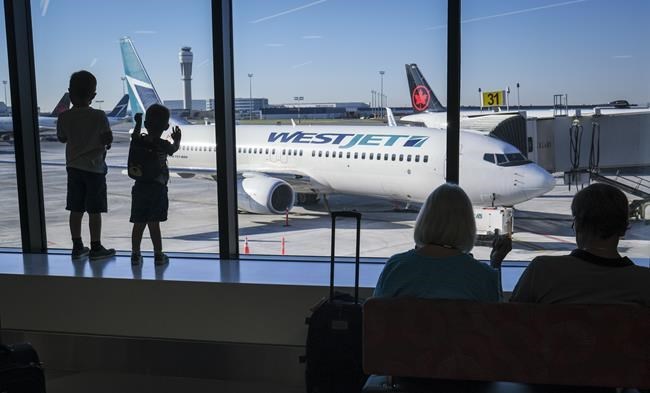MONTREAL — After entertaining new entrants for several years, sa╣·╝╩┤½├Į's airline market is once again on the path to consolidation, raising the likelihood of higher fares and fewer flight options.
Since May, newer low-cost carriers Swoop and Lynx Air have disappeared from the skies and WestJet has scooped up Sunwing Airlines.
The latter two made up 37 per cent of seat capacity on direct flights to sun destinations and 72 per cent from Western sa╣·╝╩┤½├Į last year, according to an October report from the Competition Bureau. It said eliminating the rivalry between WestJet and Sunwing would likely suppress competition around the sale of vacation packages.
"We’ve lost 40 per cent of the players in the space of the last 12 months," said John Gradek, a lecturer at McGill University's aviation management program.
“The question is, are we done?”
The shrinking airline tally could mean less service and higher prices, particularly in the West and smaller markets across the country.
“The fewer competitive entities you have in sa╣·╝╩┤½├Į, the less pressure you have to be price-competitive," Gradek said.
Air sa╣·╝╩┤½├Į and WestJet have strengthened their grip on the domestic market over the past year, even as rival Porter Airlines rapidly expands in a bid to become the country's third major airline.
sa╣·╝╩┤½├Į's two largest carriers commanded 79 per cent of domestic traffic this month versus 74 per cent a year earlier, statistics from aviation data firm Cirium show.
The diminishing set of operators coincides with a nearly seven per cent decrease in domestic flight volume between March 2023 and this month, though that may be due in part to a renewed focus on international trips.
While big cities remain amply served, smaller ones have fewer options, which can also result in higher prices and, when things go awry, stranded passengers.
The Edmonton-Winnipeg route saw flight numbers plummet 82 per cent to 44 in December from 242 in December 2019 after Air sa╣·╝╩┤½├Į and Swoop ceased to ply it. Only WestJet remains, and it makes less than half as many trips per month as it did four years earlier, according to Cirium.
Between Calgary and Saskatoon, flight figures fell by over 50 per cent to 349 in December from 702 in December 2019, now that the airspace between Alberta and Saskatchewan's biggest cities is served with non-stop flights by WestJet only — Air sa╣·╝╩┤½├Į pulled out over a year ago to shore up further east. In the same period, the average price of a ticket on the route rose 27 per cent, Cirium data reveals.
Ironically, the COVID-19 pandemic that hammered the travel industry opened the gate to new entrants. And now that business is booming again, ownership is concentrating.
"In recessionary periods, there's a lot of airplanes suddenly on the market at a low cost," said Barry Prentice, director of the University of Manitoba's transport institute.
The glut of jetliners abruptly available for lease along with the 20-month grounding of the Boeing 737 Max 8 due to two fatal crashes made those aircraft particularly cheap. "So that's what Flair picked up, and Lynx and others," Prentice said.
"People are free to get in — that's what free enterprise is. And they're free to go broke."
Calgary-based Lynx, which shut down last month after filing for creditor protection, marks at least the eighth budget airline to take off and then fizzle out since 2000, joining the ranks of Roots Air, CanJet and Swoop.
Last fall, Calgary-based WestJet folded its Swoop subsidiary under its main banner. It also aims to wind down Sunwing and integrate the discount carrier into its mainline business by October after buying the Toronto-based company last May.
High airport rents, security fees and fuel taxes raise the baseline cost of flying, making it harder for budget airlines to coax budget-conscious Canadians on board — and thus to sustain themselves and a broader base of competition.
Pearson's "airport improvement fee" on a no-frills, one-way Flair flight booked this week between Toronto and Fort Lauderdale, Fla., for April amounts to $35, or one-third of the $107 ticket (most U.S. airports charge US$4.50). A security charge tacks on another $12. For a family of four, that adds nearly $200 to the journey.
“That makes a difference between travelling and not travelling,” said Flair CEO Stephen Jones. “It's a big deal.”
The market's decades-long domination by Air sa╣·╝╩┤½├Į and WestJet can also stifle competition, he said.
"There is no interest by the big carriers in having low-cost carriers succeed, and they'll use the tools that they've got in the toolkit to try and bring carriers like Lynx to an end," Jones claimed.
In late 2018, the Competition Bureau opened an investigation into predatory pricing tactics allegedly deployed by WestJet and Swoop on some routes flown by Flair, which had launched the previous year.
The regulator wound down its probe nearly five years later without taking further steps. The decision came despite then interim competition commissioner Matthew Boswell accusing WestJet and Swoop in 2018 of "engaging in ... predatory pricing by significantly decreasing the prices of their passenger tickets to a level that appears to be below their avoidable costs."
"I am unable to comment on any findings," said spokesman Jayme Albert in an email Wednesday, noting that federal law requires the agency to work confidentially.
"That said, we take action whenever we find evidence of conduct that is prohibited by the Competition Act," added spokeswoman Georgia Simone Fakiolas.
Lynx, which launched its first flight in April 2022 and halted operations on Feb. 26, said in court filings that rising costs, airports charges and "a competitive aviation landscape have proved disastrous."
This report by The Canadian Press was first published March 13, 2024.
Companies in this story: (TSX:AC)
Christopher Reynolds, The Canadian Press



